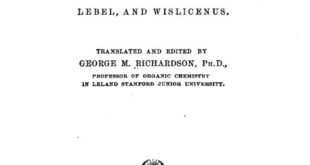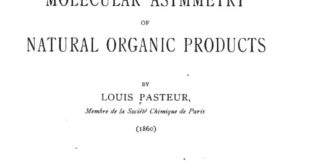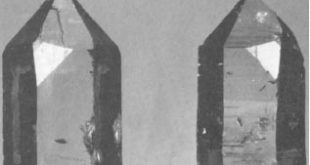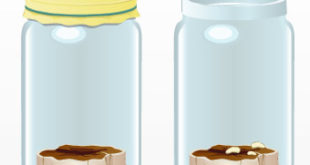There is a time in every man’s life when he looks to his God, when he looks at his life, when he wonders how he will be remembered. It can happen with age or with tragedy or closeness of death. I am lying here at age 45, not able to feel my left side. Not knowing if this stroke that has befallen me will end my life before the mysteries that I have unlocked can be resolved. I have asked God throughout my life to be able to “…bring a little stone to the frail and ill assured edifice of our knowledge of those deep mysteries of Life and Death where all our intellects have so lamentably failed.” (Vallery-Radot, 88)
Death is more familiar to me than I care to think… three of my daughters.. .my father..” I have been thinking all day of the marks of affection I have had from him. For thirty years I had been in his constant care, I owe everything to him. When I was young he kept me from bad company and instilled into me the habit of working and the most loyal and best filled life. He was far above his position (tanner) both in mind and in character. The touching part of his affection for me is that it was never mixed with ambition…and yet, I am sure that some of the success in my scientific career must have filled him with joy and pride…”(Vallery-Radot, 119)
Science…it is my life..it has brought me a deepness of pleasure that I have always known yet never realized. I remember when I was working on the tartrates, tartaric acid and racemic acid or paratartrate. Tartaric acid was known to rotate light to the right, whereas paratartrate, odly enough, did not affect light in the least. “The fortunate idea came to me to orient my crystals with reference to a plane perpendicular to the observer, and then I noticed that the confused mass of crystals of paratartrate could be divided into two groups according to the orientation of their facets of symmetry. In one group, the facet of symmetry nearer my body was inclined to my right with reference to the plane of orientation which I just mentioned, whereas the facet of asymmetry was inclined to my left in the other. The paratartrate appeared as a mixture of two kinds of crystals, some asymmetric to the right, some asymmetric to the left.
A new and obvious idea soon occured to me. These crystals asymmetric to the right, which I could separate manually from the others, exhibited an absolute identity of shape with those of the classical right tartrate. Pursuing my preconceived idea, in the logic of its deductions, I separated these right crystals from the crystallized paratartrate; I made the lead salt and isolated the acid; this acid appeared absolutely identical with the tartaric acid of grape, identical also in its action on polarized light. My happiness was even greater the day when, separating now from the paratartare the crystals with asymmetry at their left, and making their acid, I obtained a tartaric absolutely similar to the tartaric acid of grape, but with an opposite asymmetry, and also with an opposite action on light. Its shape was identical to that of the mirror image of the right tartaric acid and, other things being equal, it rotated light to the left as much in absolute amount as the other acid did it to the right.
“I remember hurrying from the laboratory and grabbing one of my chemistry assistants and excitedly telling him that ‘I have made a great discovery…I am so happy that I am shaking all over and am unable to set my eyes against the polarimeter.’ At this time, I was twenty-five years old and had only been doing research for two years. ” (Dubois, 27-28)
Before my work could be presented to the public it had to be verified in the presence of a notable scientist, in this case, Jean Baptiste Biot. I was called to ‘repeat before his eyes the several experiments and he gave me a sample of racemic acid which he had himself previously examined and found to be quite inactive toward polarized light. I prepared from it, in his presence, the sodium ammonium double salt, for which he also desired himself to provide the soda and ammonia. The solution was set aside for slow evaporation in one of the rooms of his own laboratory, and when thirty to forty grams of crystals had separated, he again summoned me to the College of France so that I might collect the dextro and levorotatory crystals before his eyes, and separate them according to their crystallographic character-asking me to repeat the statement that the crystals which I should place on his right hand would cause deviation to the right, and the others to the left. This done, he said that he himself would do the rest. He prepared the carefully weighed solutions, and at the moment when he was about to examine them in the polarimeter, he again called me into the laboratory. He first put into the apparatus the more interesting solution, the one which was to cause rotation to the left. At the first sight of the color tints presented by the two halves of the field in the “Soleil” polarimeter, and without having to make a reading, Biot recognized that there was a strong levorotation. Then the illustrious old man, who was visibly moved, seized my hand and said, ‘My dear son, I love science so deeply that this stirs my heart.’ (Dubois, 30-31)
I need to sleep now. The stroke takes a toll on me that I am not used to. When one works and imagines and dreams of nothing else than the search for answers that God has posed, it is difficult to be so still.
Marie has just awakened me to eat. She does not allow me to pick up pencil and paper in fear that I will tire and grow worse. Never before has she asked me not to work for she has always thought that the laboratory should come first.5 I remember falling in love with her and realizing how much I needed her. One time when I had been gone from home for a length of time and was in my room sleeping ‘I awoke suddenly with the thought that [she] did not love me and immediately started to cry…I had never cried so much since the death of my dear mother. My work no longer meant anything to me. I, who so much loved my crystals, I who always used to wish in the evening that the night be shorter to come back the sooner to my studies’. (Dubois, 31-32)
What is life? What are we to accomplish? Is it enough to do one’s work and be satisfied that truth has been attained? I only know that it was difficult for me when I turned to the matter of spontaneous generation to allow others to challenge and not accept my conclusions.”I wanted to pursue as best I could these studies on fermentation which were of great interest, connected as they are with the impenetrable mystery of Life and Death. I was hoping to mark a decisive step by solving, without the least confusion, the celebrated question of spontaneous generation.” (Vallery-Radot, 93) “…In my opinion, the question was whole and untouched by decisive proofs. What is there in air that provokes organization? Are they germs? is it a solid? is it a gas? is it a fluid? is it a principle such as ozone? All this was unknown and invited experiment.” (Vallery-Radot, 87) “…There was so much obscurity, together with so much passion, on both sides (concerning spontaneous generation)…I surmised that the air had to contain the germs that could cause rancidity in the fermentation process and “if germs exist in the atmosphere, could they not be arrested on their way?” (Vallery-Radot, 93) My experimental process was to draw a volume of the atmosphere through an aspirator into a tube containing a plug of cotton wool.The current as it passed through would deposit solid particles on the filter. I was convinced that this filter would also catch spores and germs. Taking the dust from the filter and disseminating it in a liquid,” I placed a portion of that infusion into a flask with a long neck.. If I boiled the liquid and left it to cool, moldiness or animalculae would develop in the liquid after a few days. By boiling I destroyed any germs contained in the liquid or against the glass; but that infusion being again in contact with the air became altered, as all infusions do. Now suppose I repeated this experiment, but that, before boiling the liquid I drew the neck of the flask into a point, leaving, however, its extremity open. This being done, I boiled the liquid in the flask and left it to cool. Now the liquid of this second flask remained pure not only two days, a month, a year, but three or four years–for the experiment I did was four years old, and the liquid remained as limpid as distilled water. What difference was there, then, between those two vases? They contain the same liquid, they both contain air, both were open! Why did one decay and the other one remain pure? The only difference between them is this: in the first case, the dusts suspended in air and their germs can fall into the neck of the flask and arrive into contact with the liquid, where they find appropriate food and develop; thence microscopic beings. In the second flask, on the contrary, it was impossible, or at least extremely difficult unless air is violently shaken, that dusts suspended in air should enter the vase; they fell on its curved neck. When air goes in and out of the vase through diffusions or variations in temperature, the latter never being sudden, the air comes in slowly enough to drop the dust and germs that it carries at the opening of the neck or in the first curves.
This experiment was full of instruction; for this must be noted that everything in air save its dusts can easily enter the vase and come into contact with the liquid. Imagine what you choose in the air–electricity, magnetism, ozone, unknown forces even, all can reach the infusion. Only one thing cannot enter easily, and that is dust, suspended in air. And the proof of this is that if I shake the vase violently two or three times, in a few days it conatins animaculae or moldiness. Why? Because air had come in violently enough to carry dust with it.” (Vallery-Radot, 108)
Thus, “..there was no circumstance known in which it could be affirmed that microscopic beings came into the world without germs, without parents similiar to themselves. Those who affirm it have been duped by illusions, by ill-conducted experiments, spoilt by errors that they either did not perceive or did not know how to avoid.” (Vallery-Radot, 109) In my passion for truth and the need to convince others of the falsity of this Aristotilean concept, I spent many hours, days, months through these last years in the hopes of putting this issue behind and letting truth reign for all.
I go in and out of consciousness, and, yet, I feel fully alert . There are so many streams of thoughts which run through my mind. I, we, owe so much to those who came before us. “Though one discovery always surpasses another, and though the chemical and physical knowledge accumuated since Lavoisier’s time has gone beyond all of his dreams, his work, like that of Newton and a few other rare spirits, will remain ever young. Certain details will age, as do the fashions of another time, but the foundation, the method, constitute one of those great aspects of the human mind, the majesty of which is only increased by years…” (Vallery-Radot, 123) This foundation, this method has been the basis for my life’s work. It requires meticulous, sometimes tedious work, and in the case of discovering the causes of the devastation of the silkworm industry, time for the experiments to progress…but it is the only way in which to reach the truth.
Will I live to finish this work on silkworms? Will I live to discover new mysteries and find these truths which God has created? Have I been able to provide a stone to this edifice of knowledge? I can only hope. “
Louis Pasteur did live through this stroke, enabling him to complete his experiments, analysis and conclusion of the problems plaguing the development of healthy silkworms. He also went on to do the work for which he was most famous, the discovery and development of vaccination for rabies and other diseases. Dumas once said of him “The art of observation and that of experimentation are very distinct. In the first case, the fact may either proceed from logical reasons or be mere good fortune; it is sufficient to have some penetration and a sense of truth in order to profit by it. But the art of experimentation leads from the first to the last link of the chain, without hesitation and without a blank, making successive use of Reason, which suggests an alternative, and of Experience, which decides on it, until, starting from a faint glimmer, the full blaze of light is reached. Lavoisier made this art into a method, and you possess it to a degree which gives me a pleasure for which I am always grateful to you.” (Vallery-Radot,122)
NOTE: In the interest of verisimilitude, some of the verb tenses of Pasteur’s quotes have been altered.
Bibliography:
Birch, Beverley, Louis Pasteur, Garth Stevens, Inc., Milwaukee WI, 1989
Dubos, René, Pasteur and Modern Science, Doubleday and Co.,Inc., New York, 1960
Vallery-Radot,Life of Pasteur, Doubleday, Page, and Co., New York, 1919.
Donald P. Berry Sr., The Woodrow Wilson National Fellowship Foundation
Debra Reynolds , The Woodrow Wilson National Fellowship Foundation
 Pasteur Brewing Louis Pasteur – Science, Health, and Brewing
Pasteur Brewing Louis Pasteur – Science, Health, and Brewing 


